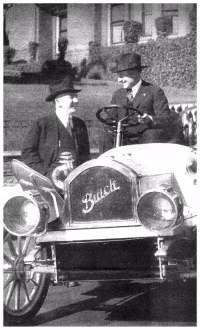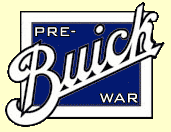When Charles Howard got out of the Army in 1903, the first year for Buick automobiles, he boarded a train for San Francisco, arriving there with 21 cents in his pocket, or so he later claimed. He got a job on Golden Gate Avenue selling bicycles. But by 1905 Howard was convinced that the next big trend would be automobiles, so he traveled to Detroit.
 That year Billy Durant took over Buick, which had built 28 cars the previous year. Durant created thirteen dealerships across the U.S. in 1905 and began looking for "born salesmen," of which he was one of the supreme examples himself. Charles Howard introduced himself, and returned to San Francisco with distributorship for eight Western states. That year Billy Durant took over Buick, which had built 28 cars the previous year. Durant created thirteen dealerships across the U.S. in 1905 and began looking for "born salesmen," of which he was one of the supreme examples himself. Charles Howard introduced himself, and returned to San Francisco with distributorship for eight Western states.
In 1906 GM built 2,295 Buicks, so Howard had plenty of product to sell on the West Coast. He personally recruited all salesmen and business was brisk from the start. Howard attributed his tremendous success to advertising, some of which was real stunt work. His first such maneuver was in 1907 when he drove a two-cylinder buick from San Francisco to Oakland via San Jose. The trip took five hours.
In 1910 an entire trainload of Buicks was shipped to San Francisco. The train carried 134 new cars and became an instant tourist attraction. Howard followed this with a load of 254 in 1912, and then again with seventy-five cars carrying 375 new Buicks, which was the largest first-class freight shipment in history up to that time in the U.S. People lined the tracks just to see the spectacle. The trains were routed through small towns in an all-daylight procession just for the effect. It worked well. Within a few years, one out of ten Buicks built was sold through Charles Howard's distributorship. By 1912 California ranked second after New York in new car registrations.
The following year Howard moved from his store on Golden Gate Avenue to a new four-story building on Van Ness at California Avenue. The showroom had a 22-foot ceiling and included opera house-style semicircular staircases with 40,000 square feet in overall floor space. In another stunt, Howard led a caravan of Buicks into Yosemite Valley. This was at a time when motor vehicles were prohibited there, and Howard was nearly arrested, but the headlines made for good advertising.
In 1915 Billy Durant, the head of General Motors, was in deep financial trouble, having overextended the company through acquisitions. It was Charles Howard who loaned him $3 million, in the process obtaining GM stock which would quickly lead to financial fortune. During the 1920s Howard was called "the world's largest motocar dealer." Journalists were not referring to Howard's weight and height.
Charles Howard lived a lavish lifestyle, with newspapers stating that "he belonged to every golf club in the state of California." He owned a 163-foot yacht, which was berthed at the St. Francis Yacht Club. He also owned a 16,000-acre cattle ranch and raced horses. Reportedly, his best year was 1941 when he collected a percentage on 30,000 Buicks.
From the beginning of his career as a car salesman, Charles Howard's statement, "I wouldn't give $50 for the fastest horse alive," was to be his most ironic. He finished his last years racing horses very successfully. In 1950 his horse, Noor, won the Handicap and defeated Kentucky Derby's famous Citation four times, setting new records each time.
1950 was also the year Charles Howard passed away.
For more information about Charles Howard, and about the Buick sales organization in general, find a copy of "The Buick - A Complete History" by Terry Dunham and Lawrence Gustin. The revised fifth edition was published in 1997 by Automobile Quarterly, Inc.
|

